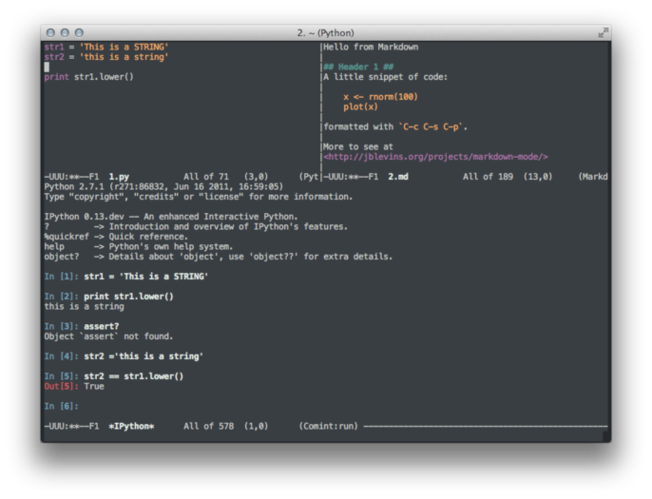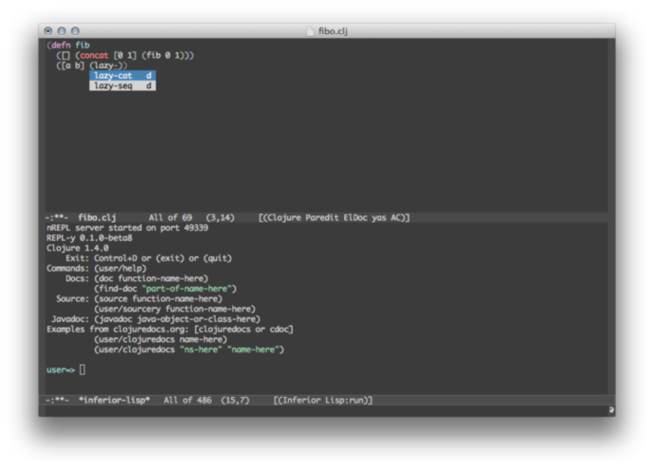GNU Emacs on OS X 10.7
I have been using Aquamacs for over 5 or 6 years now, but I recently decided to go back to a simpler version of Emacs, namely the latest build of Emacs for OS X.
Why? There are several reasons:
- I wanted to rewrite a cleaner configuration file and use the ELPA package manager. OS X has no package manager, at least no one that I use like, e.g., Homebrew — anyway, I like compiling everything from scratch so that I know where things go to be installed. However, with time I have accumulated a large collection of
.elfiles in my.lisp.ddirectory, and almost half of them are outdated. - Aquamacs provides a rich set of facilities for people living with a Mac (key bindings, fullscreen support, etc.) and I have downloaded several versions from the developmental branch without any difficulties. Now, there are tons of gadgets that I don’t use, and it doesn’t work well when it runs in a terminal, and the Emacs that ships with Apple Macbook is version 22.1!).
- This lead me to re-read a lot of documentation, which is quite good because with time we tend to rely on automated commands, sometimes without knowing how they are implemented.
Everything started with my looking at the overtone project (following a post mirrored on Planet Clojure). There’s a nice screencast on the Github website, and I also found this one:
So basically, the author customized his emacs with a lot of add-ons, especially to assist coding activity: auto-complete, snippets, connection to various REPLs, etc. I wanted to do the same, but without using the complete overtone configuration files. That’s almost done!
Be sure to grab one of the 24.* series in the build repository. I personally choose the 24.1-rc pretest version. I haven’t had any problem so far.
To configure ELPA, we can add the following two lines in our .emacs:
(setq package-archives
'(("marmalade" . "http://marmalade-repo.org/packages/")
("tromey" . "http://tromey.com/elpa/")))
This will add Marmalade as well as Tromey ELPA to the default GNU repository. Something that’s really important is to configure the keyboard; in order to exchange command the option (⌥) and command (⌘) keys, I just added
(setq mac-option-modifier 'none)
Otherwise, we cannot type symbols like ~ (Alt-n), or use square brackets (which is pretty sad when writing R code :-). Other customizations can be added, for example to make the connection with Mac pbpaste more transparent.
I was aware of Yasnippet, which is inspired from Textmate, but I just gave it a try in the past. Now, I’m using it and it seems the trigger key (⇥) is not too intrusive when I’m typing.
I am also trying to familiarize myself with ido-mode that I’ve never used:
(require 'ido)
(ido-mode t)
My first impressions were disconcerting, but now I seem to get used to it. I just have to remember that I now have to C-d to get into dired-mode for browsing content of a directory.
My .emacs is not entirely clean at the moment: I need to investigate the autoload vs. require issue more carefully. For the moment, I am quite happy with the configuration of Lisp, Clojure, R, and Python. I can connect to Slime using either lein swank or M-x clojure-jack-in from within Emacs. For R, I have Yasnippets working right out of the box, together with other goodies from ESS. I was previously using the Stata ado-mode, but ess-mode provides most of the basic functionalities I need for interacting with Stata.
An example of an interactive R session is shown below:

Top panel shows how Yasnippet prompting tool is triggered when pressing tab (⇥), while bottom panel shows available arguments when typing rnorm in the R shell directly.
Here is another screenshot which show the beginning of a clojure script with auto-completion and a running lein shell (left), and one (right) with two buffers with Yasnippet providing basic construction of a defn in Clojure (top), or suggesting methods in Python mode (bottom).
:
Finally, this configuration works equally well when Emacs run in a Terminal (nw), as can be seen below:


